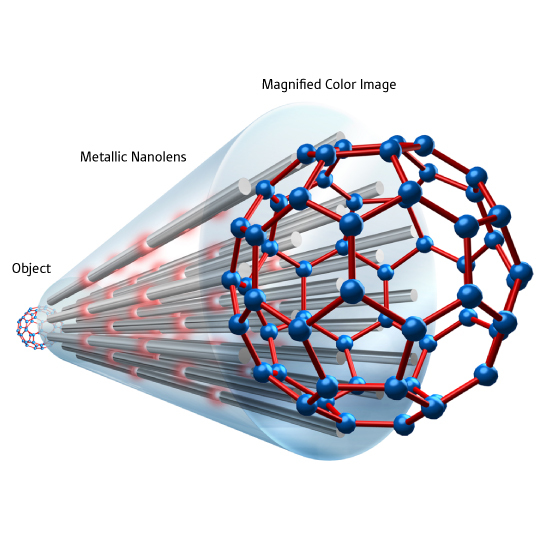Home > Press > Color to the nanoworld: New design concept for a tiny metallic lens tipped to revolutionize imaging of nanoscale objects
 |
| Figure 1: A metallic nanolens. Plasmonic resonances along stacked silver nanorods are capable of long-distance image transfer and magnification. |
Abstract:
Researchers in Japan have developed a design concept for a device that allows imaging at scales previously impossible for optical instruments. Their advance is based on novel imaging techniques that allow optical imaging in the subwavelength regime, where the wavelength used is larger than the smallest features of the object being imaged. However, although subwavelength imaging is capable of significantly expanding the resolution of optical microscopes, a drawback of existing designs is that they only work at a single wavelength and in close proximity to a sample.
Color to the nanoworld: New design concept for a tiny metallic lens tipped to revolutionize imaging of nanoscale objects
Japan | Posted on October 10th, 2008The approach developed by Satoshi Kawata's team, with members from RIKEN's Advanced Science Institute, on the other hand, allows subwavelength imaging in color and at large distances from the sample. "Such nanolenses could be used to directly image viruses or the distribution of proteins in cell membranes," says Kawata, commenting on the promise of the research.
Subwavelength imaging is based on plasmonic resonances, which are collective motions of electrons at the surface of a metal that can significantly amplify light waves in the vicinity of a metal. These amplified light fields can then be used for subwavelength imaging. However, these light fields decay rapidly away from the metal, so their use in actual imaging applications is rather limited.
Reporting in Nature Photonics, the researchers present a device concept that offers a promising solution to this problem1. Similar to a relay race, light is passed along a chain of silver nanorods (Fig. 1). A full image can be transmitted when a large number of stacked rods are bundled together.
The gaps along the stacked nanorods play an important function, despite appearing cumbersome. Firstly, the plasmonic resonances in the gaps replenish the transmitted light field that would decay rapidly along longer nanorods. Secondly, the gaps perturb the plasmonic resonances along the transmission line. As calculations by the researchers have revealed, this broadens the wavelength range that the rods can transmit, and enables the transmission of different colors along the structure. Finally, magnification of the light can be achieved if the rods are arranged such that they are tapered, which gradually expands the image as it is transmitted along the rods.
With such promising predictions, the next will be to build a device based on this concept. Whilst the researchers are continuing to improve their device design, Kawata is certain that "this invention will replace conventional lens-based optical microscopes with metallic nanolenses capable of extremely high resolution."
Reference
1. Kawata, S., Ono, A. & Verma, P. Subwavelength colour imaging with a metallic nanolens. Nature Photonics 2, 438-442 (2008).
The corresponding author for this highlight is based at the RIKEN Nanophotonics Laboratory
####
For more information, please click here
Copyright © Riken
If you have a comment, please Contact us.Issuers of news releases, not 7th Wave, Inc. or Nanotechnology Now, are solely responsible for the accuracy of the content.
| Related Links |
| Related News Press |
News and information
![]() Researchers develop molecular qubits that communicate at telecom frequencies October 3rd, 2025
Researchers develop molecular qubits that communicate at telecom frequencies October 3rd, 2025
![]() Next-generation quantum communication October 3rd, 2025
Next-generation quantum communication October 3rd, 2025
![]() "Nanoreactor" cage uses visible light for catalytic and ultra-selective cross-cycloadditions October 3rd, 2025
"Nanoreactor" cage uses visible light for catalytic and ultra-selective cross-cycloadditions October 3rd, 2025
Imaging
![]() ICFO researchers overcome long-standing bottleneck in single photon detection with twisted 2D materials August 8th, 2025
ICFO researchers overcome long-standing bottleneck in single photon detection with twisted 2D materials August 8th, 2025
![]() Simple algorithm paired with standard imaging tool could predict failure in lithium metal batteries August 8th, 2025
Simple algorithm paired with standard imaging tool could predict failure in lithium metal batteries August 8th, 2025
![]() First real-time observation of two-dimensional melting process: Researchers at Mainz University unveil new insights into magnetic vortex structures August 8th, 2025
First real-time observation of two-dimensional melting process: Researchers at Mainz University unveil new insights into magnetic vortex structures August 8th, 2025
![]() New imaging approach transforms study of bacterial biofilms August 8th, 2025
New imaging approach transforms study of bacterial biofilms August 8th, 2025
Discoveries
![]() Researchers develop molecular qubits that communicate at telecom frequencies October 3rd, 2025
Researchers develop molecular qubits that communicate at telecom frequencies October 3rd, 2025
![]() Next-generation quantum communication October 3rd, 2025
Next-generation quantum communication October 3rd, 2025
![]() "Nanoreactor" cage uses visible light for catalytic and ultra-selective cross-cycloadditions October 3rd, 2025
"Nanoreactor" cage uses visible light for catalytic and ultra-selective cross-cycloadditions October 3rd, 2025
Announcements
![]() Rice membrane extracts lithium from brines with greater speed, less waste October 3rd, 2025
Rice membrane extracts lithium from brines with greater speed, less waste October 3rd, 2025
![]() Researchers develop molecular qubits that communicate at telecom frequencies October 3rd, 2025
Researchers develop molecular qubits that communicate at telecom frequencies October 3rd, 2025
![]() Next-generation quantum communication October 3rd, 2025
Next-generation quantum communication October 3rd, 2025
![]() "Nanoreactor" cage uses visible light for catalytic and ultra-selective cross-cycloadditions October 3rd, 2025
"Nanoreactor" cage uses visible light for catalytic and ultra-selective cross-cycloadditions October 3rd, 2025
|
|
||
|
|
||
| The latest news from around the world, FREE | ||
|
|
||
|
|
||
| Premium Products | ||
|
|
||
|
Only the news you want to read!
Learn More |
||
|
|
||
|
Full-service, expert consulting
Learn More |
||
|
|
||








